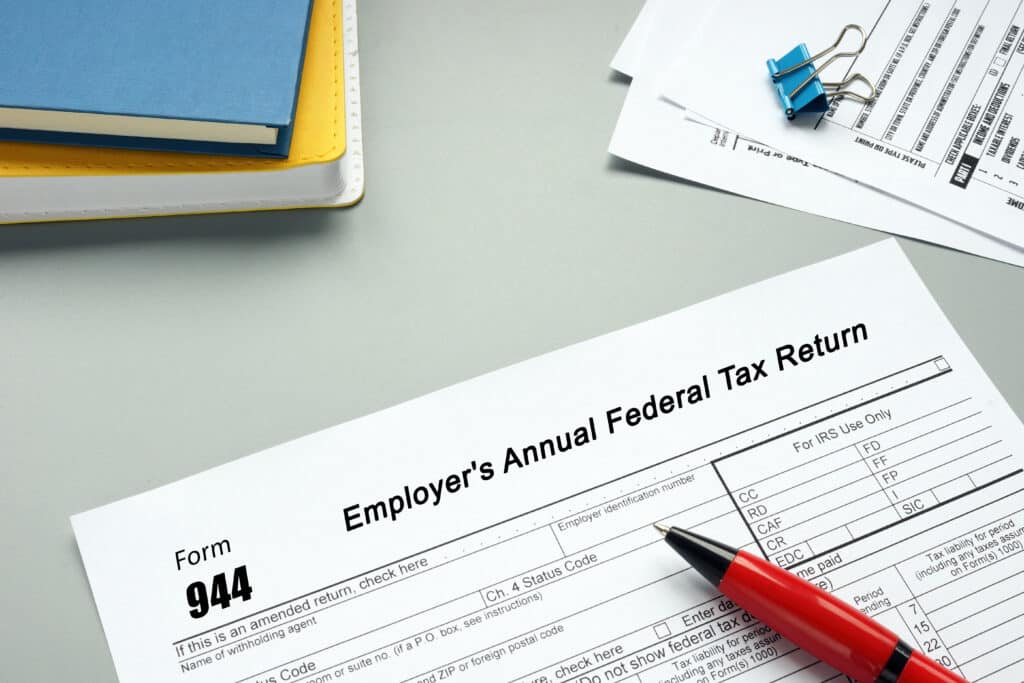IRS Form 944: How to File When Your Business Owes Less

When it comes to running a business, staying on top of your tax responsibilities is crucial. If you’re a small-scale employer, chances are you might be familiar with IRS Form 944, also known as the Employer’s Annual Federal Tax Return. In this guide, we’ll walk you through the essentials of Form 944, explaining why it matters and how to file seamlessly.
What is IRS Form 944?
IRS Form 944 is a tax form specifically designed for small businesses with a lower annual payroll tax liability. Eligible employers can use Form 944 in replacement of Form 941 to report and pay their federal payroll taxes just once a year.
Eligible employers must report the following information on Form 944:
- Payments to employees, including wages and tips.
- Federal income tax withheld
- Social Security and Medicare taxes, covering both the employer’s and employee’s contributions
- Adjustments to Social Security and Medicare, such as sick pay, tips, and group-term life insurance
- Credit for qualified sick and family leave wages
- Qualified small business payroll tax credit for research activities
Who is Eligible to Use the Form?
To determine if your business is eligible to use Form 944, the IRS considers your estimated annual payroll tax liability. If your liability is $1,000 or less during the calendar year or if you meet certain other criteria, you are likely to qualify for the use of Form 944. However, it’s important to note that the IRS, in general, issues an official notification when you are allowed to use Form 944 for reporting federal income tax. If you haven’t received the notification, it is advisable to continue using Form 941 for your tax reporting. Alternatively, you can contact the IRS and ask them to update your employment filing requirements to allow you to use IRS Form 944.
Difference Between Form 944 and 941
Form 944 operates on an annual filing basis which requires businesses to submit it just once a year. Eligibility for Form 944 is determined by having an estimated annual payroll tax liability of $1,000 or less. This form is designed to simplify reporting for smaller businesses by consolidating payroll tax obligations into one annual filing.
On the other hand, Form 941 is filed quarterly, meaning businesses submit it four times a year. It is more widely applicable and is commonly used by most businesses for reporting federal income tax, social security tax, and Medicare tax.
Advantages of Using Form 944
- Reduced Filing Frequency
One of the primary advantages of using Form 944 is the reduced filing frequency. Instead of filing quarterly, eligible businesses only need to submit the form once a year. This streamlines the process and minimizes the administrative burden for small businesses.
- Easier Record-Keeping
Form 944 also simplifies record-keeping for eligible employers. With only one annual filing, businesses can consolidate their payroll tax responsibilities, making it easier to maintain accurate records throughout the year. This simplicity can save time and resources which allows business owners to focus on other critical aspects of their operations.
Step-by-Step Guide to Completing Form 944
Now that we have a clear understanding of what Form 944 is, let’s delve into the step-by-step process of filling out the form. For the most up-to-date version of the form, you can access it directly on the IRS website.
Step 1: Gather Necessary Information
Before you start filling out Form 944, make sure you have all the essential information on hand. This includes your Employer Identification Number (EIN), total annual payroll, and records of tax payments made throughout the year. Having these data readily available will expedite the filing process.
Step 2: Complete Employer Information
Provide accurate details about your business, including your legal business name, trade name (if applicable), address, and EIN. Make sure this information matches what the IRS has on record.
Step 3: Complete Part 1
In this part, share financial information such as the total wages, tips, and compensation given to your employees. You must also report the federal income tax you withheld from their earnings this year, including qualified sick leave wages.
Step 4: Complete Part 2
Provide information about your deposit schedule and tax liability for the current year.
Step 5: Complete Part 3
Here, you indicate whether your business has closed or if you’ve ceased paying wages to your employees. If either scenario applies, mark the corresponding box and input the last date you made employee payments. If these situations don’t apply to your business, simply leave this section blank.
Step 6: Complete Part 4
Decide whether you want to authorize a third-party designee, such as an employee, a tax preparer, or another person to communicate with the IRS regarding your Form 944.
Step 7: Complete Part 5
Thoroughly review all information provided on the form. Make sure it’s accurate and complete before signing and dating the form. Your signature certifies the authenticity of the information.
Step 8: Submit the Form
It’s recommended to file Form 944 electronically for a smoother process. You can visit IRS.gov/EmploymentEfile for details on electronic filing. If you’re paper filing, where you mail it depends on whether you’re including a payment. Check the table below to find the right address.
| State | Where to Mail Return (Without Payment) | Where to Mail Return (With Payment) |
| Connecticut, Delaware, District of Columbia, Georgia, Illinois, Indiana, Kentucky, Maine, Maryland, Massachusetts, Michigan, New Hampshire, New Jersey, New York, North Carolina, Ohio, Pennsylvania, Rhode Island, South Carolina, Tennessee, Vermont, Virginia, West Virginia, Wisconsin | Department of the TreasuryInternal Revenue ServiceKansas City, MO 64999-0044 | Department of the TreasuryInternal Revenue ServiceP.O. Box 806532Cincinnati, OH 45280-6532 |
| Alabama, Alaska, Arizona, Arkansas, California, Colorado, Florida, Hawaii, Idaho, Iowa, Kansas, Louisiana, Minnesota, Mississippi, Missouri, Montana, Nebraska, Nevada, New Mexico, North Dakota, Oklahoma, Oregon, South Dakota, Texas, Utah, Washington, Wyoming | Department of the TreasuryInternal Revenue ServiceOgden, UT 84201-0044 | Internal Revenue ServiceP.O. Box 932100Louisville, KY 40293-2100 |
| No legal residence or principal place of business in any state. | Internal Revenue ServiceP.O. Box 409101Ogden, UT 84409 | Internal Revenue ServiceP.O. Box 932100Louisville, KY 40293-2100 |
| Exception for Exempt Organizations, Federal, State, and local Government Entities, and Indian Tribal Government Entities regardless of location | Department of the TreasuryInternal Revenue ServiceOgden, UT 84201-0044 | Internal Revenue ServiceP.O. Box 932100Louisville, KY 40293-2100 |
Form 944 Filing Deadline
For the tax year 2023, you must file your Form 944 by January 31, 2024. If you’ve been diligent in making timely and complete deposits, covering all your taxes due, you have an extended deadline until February 12, 2024.
Conclusion
IRS Form 944 provides small business owners with a breath of fresh air from the quarterly hassle that comes with filing Form 941. It not only simplifies the tax reporting process but also minimizes the administrative load for businesses.
If you have any questions or require any assistance with Form 944 and other tax-related concerns, we’re here to help. Our team of experts is dedicated to providing personalized guidance tailored to your specific needs.
Contact us at 775-305-1040 or visit our website at Tax Samaritan to explore our range of services.


